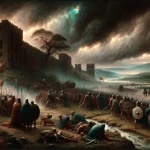The Great Conspiracy marked a tumultuous year of conflict and chaos towards the end of Roman rule in Britain. Historian Ammianus Marcellinus termed it “barbarica conspiratio,” highlighting the crisis spurred by a weakened military after many soldiers had left to support Magnentius’s failed attempt to claim the imperial throne, with few returning to Britain. This left the military under-resourced and lacking in discipline in the ensuing period.
Pinpointing the sequence of these events is challenging due to Ammianus’s distance from them, as he resided in Antioch, resulting in a narrative that appears second-hand and somewhat disordered, occasionally conflicting with other accounts.
Ammianus records that in the winter of 367, a mutiny by the Roman garrison on Hadrian’s Wall allowed Picts from Caledonia to breach Britannia. Concurrently, coordinated invasions by the Attacotti, the Scotti from Hibernia, and the Saxons from Germania overwhelmed Roman defenses across Britannia’s mid-western and southeastern shores. This onslaught led to the sacking of cities and widespread violence against the Romano-British population. In parallel, Franks and Saxons launched incursions into northern Gaul.
The Roman military leadership suffered significant losses, with Nectaridus, the maritime commander, killed, and a regional commander, Fullofaudes, either captured or besieged. While these defeats are commonly believed to have occurred in Britain, some speculate they might have taken place in Gaul. The surviving Roman forces were confined to garrisons in the southeastern cities.
Complicity by the miles areani, Roman intelligence operatives, through bribery by barbarian forces, left the Roman defenses unprepared for the invasions. The resulting disorder saw deserting soldiers and escaped slaves turning to robbery, with insurgent groups prioritizing personal gain over collective military objectives, operating more as raiding parties than formal armies.
In response to the crisis, Emperor Valentinian I, engaged in conflicts with the Alamanni, delegated a series of commanders to address the situation, all of whom were swiftly replaced or recalled due to the pressing needs elsewhere, particularly along the Rhine.
Severus, initially tasked with the response, was quickly replaced by Jovinus, who upon requesting reinforcements, was also recalled. Valentinian then appointed Flavius Theodosius to lead the relief effort. By the spring of 368, Theodosius assembled a force in Bononia, which included future notable figures such as his son, the future Emperor Theodosius I, and likely Magnus Maximus, his nephew.
Seizing a break in the winter weather, Theodosius crossed to Richborough, leaving his main forces in Bononia to await better conditions. This strategic move allowed him to gather crucial intelligence on the ground in Britain, revealing the dire state of the Roman troops there. Upon the arrival of his forces, Theodosius advanced to Londinium, establishing it as his operational base to commence the counteroffensive against the invaders.
There he divided his troops into many parts and attacked the predatory bands of the enemy, which were ranging about and were laden with heavy packs; quickly routing those who were driving along prisoners and cattle, he wrested from them the booty which the wretched tribute-paying people had lost. And when all this had been restored to them, except for a small part which was allotted to the wearied soldiers, he entered the city, which had previously been plunged into the greatest difficulties, but had been restored more quickly than rescue could have been expected, rejoicing and as if celebrating an ovation.
Ammianus Marcellinus, Res Gestae 27.8.6
Theodosius offered amnesty to deserters, which facilitated the re-garrisoning of deserted forts. He appointed Dulcitius as the new Dux Britanniarum and granted Civilis vicarius status to lead a revamped civilian government. After uncovering the collusion between the local areani and the invaders, Theodosius dismissed them from service.
By the year’s end, the invaders had been repelled to their territories, mutineers were dealt with, Hadrian’s Wall was secured again, and order was restored across the diocese. Under Civilis’s leadership, the remnants of the invaders were expelled in AD 369, likely with forces directly commanded by him, initiating a phase of civil recovery.
Theodosius also successfully quashed the rebellion led by Valentinus, a Pannonian exile who had sided with the invaders.
Significant restructuring in Britain ensued, including the establishment of a new province named Valentia, aimed at improving governance in the northern regions. The poet Claudian hints at naval operations in northern Britain around this time.
Theodosius likely led punitive missions against the barbarians, securing terms of peace. This is supported by the Notitia Dignitatum’s later mention of four Attacotti units serving Rome in the Continental army. The areani were stripped of their duties, and the frontiers were strengthened with assistance from neighboring tribes like the Votadini, showcasing the esteemed careers of individuals such as Paternus.
The successful resolution of the crisis elevated Theodosius’s status, leading to his return to Rome as a celebrated hero and his appointment as the senior military advisor to Valentinian, succeeding Jovinus. His efforts laid the groundwork for his son’s eventual rise to emperor.
Despite the Roman efforts to restore stability, raids by the various groups involved in the conspiracy persisted, indicating the ongoing challenges faced by Roman Britain.
